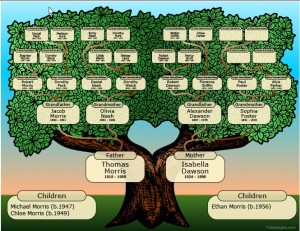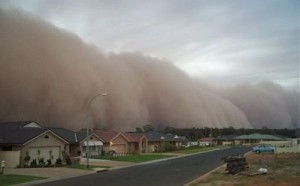Archive for August 2013
Study: Maternal Smoking During Pregnancy Can Cause Asthma In Your Great Grandchildren
 And the evidence just keeps piling-up that we have no clue about the public health impacts of poisoning ourselves.
And the evidence just keeps piling-up that we have no clue about the public health impacts of poisoning ourselves.
Over the past few years, more and more science dollars have been committed to studying the "epigenetic" impact of toxins in the human body. These are impacts that go well beyond just the person originally exposed to those toxins. We expect that harm. What's brand new is the fact that that exposure can keep harming the descendants of the original victim. His or her children could be impacted, or his or her grandchildren, or even great-grandchildren. Individuals who might be born long after the offending facility is out of business can nevertheless still be impacted by its poisons as the get passed along from generation to generation.
This happens not through direct DNA damage, but by damaging the code and behavior of the stuff surrounding the DNA and telling it what to do. This damage can cause a normal cell to go haywire. Changes can be subtle or dramatic. Maybe cancer, maybe a immune system disease, and maybe asthma.
Researchers at the UCLA Medical Center have published a study that concludes that mothers who smoke during pregnancy have a statistically higher risk of causing asthma in their great grandchildren.
"Even though there are multiple causes for childhood asthma, research linking this serious chronic condition to maternal nicotine exposure during pregnancy for up to three generations should give mothers-to-be even more reasons to reconsider smoking,’ said Dr Virender Rehan an LA BioMed lead researcher. "
Follow-Up: Silica Air Pollution at Fracking Sites Out of Control
 Last summer we told you about a nationwide Centers For Disease Control/National Institute for Occupational Safety and Health (NIOSH) warning to gas and oil field workers about rampant silica air pollution at fracking sites throughout the country. Research had found that pollution standards were being trampled at every site they tested. These were all tests done within the fence line of the well site, so nobody knows what the off-site impacts were/are, or how far downwind they can extend.
Last summer we told you about a nationwide Centers For Disease Control/National Institute for Occupational Safety and Health (NIOSH) warning to gas and oil field workers about rampant silica air pollution at fracking sites throughout the country. Research had found that pollution standards were being trampled at every site they tested. These were all tests done within the fence line of the well site, so nobody knows what the off-site impacts were/are, or how far downwind they can extend.
Now comes a recent follow-up report that breaks down all the information that was the basis of that 2012 industry warning, and its gruesome. Because it's so detailed, we're pasting it in blocks below in one narrative feed.
Fracking uses a lot of sand. There's an entire silica pollution cycle within fracking that's only now getting the attention it deserves. The mining of sand for fracking can take place miles away from the gas or oil plays and threaten new areas never touched by a well. It takes lots and lots of water. There are lots and lots of trucks, and lots of silica in the air at the mine. Just ask the folks along the Red River, to the northwest of DFW in what used to be pristine rolling timbered hill country.
Once it gets to the fracking site, it creates the clouds of silica air pollution that OSHA is so concerned about. The level of exposure the feds found at some of the fracking sites they studied was "enough to overwhelm the maximum use concentration ratings for the half-mask, air-purifying respirators that workers typically wore" while working at the site. Breathing silica is like breathing sand or cement into your lungs. Eventually it fills them up and hardens your air passageways and you suffocate to death. Happens in the cement industry a lot. We know this is a real and current hazard to workers at the site. We have no idea what kind of hazard it is to people off-site. None. Zero. Nada.
This is why regulators must be cautious in deciding things like "setback distances." The difference between 1000 and 1500 feet could be a dramatic drop-off in silica pollution. That could be an important margin of error for public health we need but don't know much about right now.
Here's the story from Robert Iafolla in Bloomberg:
Workers' Silica Exposure at Fracking Sites Far Exceeds OSHA Limit, NIOSH Study Finds
The concentration of silica in the air workers breathe exceeded occupational health criteria at all 11 hydraulic fracturing sites tested by the National Institute for Occupational Safety and Health, the American Industrial Hygiene Association announced July 31.
Researchers measured the silica levels of more than 100 personal breathing zone samples at fracking sites in five states, finding levels above the Occupational Safety and Health Administration's permissible exposure limit (PEL), NIOSH's recommended exposure limit (REL), and the American Conference of Governmental Industrial Hygienists threshold limit value (TLV).
In some instances, the samples exceeded OSHA's PEL by a factor of 10 or more. That level of exposure is enough to overwhelm the maximum use concentration ratings for the half-mask, air-purifying respirators that workers typically wore, the study said.
“Although effective engineering controls for crystalline silica are well established in other industries, controls to limit silica-containing dust generation during hydraulic fracturing are only now emerging due to the relatively recent understanding of the hazard and magnitude of exposure risks,” the study authors wrote.
The study appears in the Journal of Occupational and Environmental Hygiene, published jointly by AIHA and ACGIH.
NIOSH first flagged the occupational hazard of silica exposure at fracking sites in a June 2012 Hazard Alert. The journal article describes the research that informed that alert (42 OSHR 576, 6/28/12).
Silica sand is a crucial and common component in many fracking operations. Silica is often mixed with the water and chemicals injected into shale formations during fracking, with silica acting as a “proppant” to keep the underground fractures open to allow oil or natural gas to flow. Approximately 28 million metric tons of silica sand was used in fracking during 2012, according to the U.S. Geological Survey.
The heavy use of silica is reflected in the air contamination at fracking sites. Just over half of the 111 samples that NIOSH tested exceeded the PEL for silica, while 69 percent exceeded the REL, and 84 percent exceeded the TVL.
OSHA's PEL is calculated from the percent of crystalline silica in the respirable dust; the PEL for 100 percent silica would be 0.1 milligram per cubic meter of air. NIOSH's REL is 0.05 milligram per cubic meter, and the ACGIH's TVL is 0.025 milligram per cubic meter.
OSHA's proposed regulations for silica could lower the PEL to 0.05 milligram per cubic meter, although that has been met with fierce resistance from industry. The proposal has been on hold at the White House Office of Management and Budget since February 2011.
Researchers took samples at fracking sites at five shale formations: Bakken in North Dakota, DJ Basin in Colorado, Eagle Ford in Texas, Fayetteville in Arkansas, and Marcellus in Pennsylvania. The fracking operations at those locations used silica as the proppant, with the exception of the Bakken site, where 60 percent of the proppant was a ceramic material.
None of the 10 samples taken at Bakken exceeded OSHA's PEL. Two-thirds of the samples at Marcellus, 54 percent at Fayetteville, 53 percent at DJ Basin, and 50 percent at Eagle Ford went over the PEL.
Typical fracked gas or oil wells go through 12 to 20 stages, with each stage requiring hundreds of thousands of pounds of sand, creating airborne dust at the sites, the study said.
Sand is delivered from tractor trailers and pumped with compressed air through fill ports into on-site storage and delivery vehicles known as “sand movers.” Those sand movers use motor-driven belts called “dragon tails” to supply sand to blender trucks, with larger loads requiring multiple vehicles moving sand across a transfer belt. Blender hoppers pump the sand-as-proppant through a manifold, piping, and into the well.
Workers operating sand movers and transfer belts are exposed to the highest levels of silica, the study said.
Overall, the study found seven points of dust generation that were common at all 11 sites:
• from “thief hatches” on the tops of sand movers during filling,
• from the sand mover belt,
• from the momentum of falling sand below the dragon tail at the blender hopper,
• from transfer belts when sand is deposited onto the belt and conveyed to the blender,
• from sand leaving the end of the dragon tail,
• from fill ports of sand movers during refilling operations, and
• from truck traffic at the fracking site.
The study said that about 435,000 workers were employed in the U.S. oil and gas extraction industry during 2010, with nearly half employed by well servicing companies, including companies that use fracking.
The study “Occupational Exposures to Respirable Crystalline Silica During Hydraulic Fracturing” is available at http://tinyurl.com/mn5sbc3.
Dallas Public Participation Rollback Continues: Staff Eliminates Aug 15th Public Hearing, Provide None in Evening
 And just like that, Dallas City Hall decides that more public participation in writing the new gas drilling ordinance isn't what they want after all.
And just like that, Dallas City Hall decides that more public participation in writing the new gas drilling ordinance isn't what they want after all.
Less than two weeks after releasing a proposed schedule for the City Plan Commission that included three public hearings on the subject, city staff issued a revised schedule for the Plan Commission that scraps the first public hearing for August 15th, and leaves the other two in the middle of the day despite appeals from the Plan Commission itself to arrange for evening public hearings.
Now, the first chance citizens will get to weigh in will be August 22nd at 1:30 pm instead of 4 to 6 pm on the 15th.
What is City Hall scared of? You.
If they had their way, some city staff would sequester members of the CPC in an undisclosed location for the duration of this process, with no opportunity to get contaminated by views other than their own – which are motivated by still trying to accommodate the discredited Trinity East permits.
You represent a complete repudiation of that point of view.
You're armed with the latest science. They want to rely on 2-year old Dallas Task Force recommendations that they also engineered to help Trinity East and ignore everything that came after that.
You're armed with real-life experience of what it's like to live near these kinds of operations. They want the CPC to rely on the soothing assurances from industry and paid-for regulators.
You want an objective reckoning of the facts and hazards. They want to find a way to get Trinity East its permits.
The Plan Commission meets this Thursday at City Hall beginning at 8:30 am in room 5ES with another workshop session lasting until at least 1:30 pm coving topics such as Pad Operations, Site Monitoring, and Permitting. There will be no opportunity for official public comment, but if you want to make unofficial comments on how undemocratic this process is becoming, be our guest. Concerned citizens need to take back their city from out-of-control staffers who want to give permits to discredited companies and sites based on secret deals, no matter the cost to public health or safety. Grabbing back control of the reigns becomes a public duty at this point.
New Proposed Schedule for City Plan Commission Drafitng of Gas-Drilling Ordinance
AUGUST
August 8th Meeting
8:30 – 9:00 am Review of Draft Ordinance
9:00-10:30 am Review of Topics
Pad Site Operations
Gas Drilling/Well Permit
Bonding Requirements
Site Monitoring and Review of Permit Application
Required Plans
10:30-11:00 am
Summary of discussion topics for the day
Revisit previous topics
11:00 am -1:30 pm – CPC Briefing (working lunch)
1:30 pm – CPC hearings on zoning cases
Immediately following CPC Public Hearing – 6:00 pm
Continue discussion of unfinished topics for the day
AUGUST 22 Meeting
8:30 am – 9:00 am Review of Draft Ordinance
9:00 am -10:30am
Physical Pad Site
Emergency Response
Abandonment and Restoration
10:30-11:00
Summary of discussion topics for the day
Revisit previous topics
11:00-1:30 CPC Briefing (working lunch)
1:30pm: 1st CPC Public Hearing on Gas Drilling
SEPTEMBER
September 12th Meeting
8:30 – 9:00
Review of drafted provisions of the Ordinance
9:00-10:30
Discussion of next Topics:
Air Quality
Water
Seismic Permits
Pipelines
Compressors
10:30-11:00
Summary of discussion topics for the day
Revisit previous topics
11:00-1:30
CPC Briefing (working lunch)
September 26
8:30 – 9:00
Review of drafted provisions of the Ordinance
9:00-10:30
Finish discussion of topics from previous meeting
10:30-11:00
Summary of discussion for the day
Revisit previous topics
11:00-1:30
CPC Briefing (working lunch)
1:30 pm: 2nd AND LAST Public Hearing on Gas Drilling at CPC
After public hearing – vote to make recommendations to City Council
Ozone Season Update: July Goes Out Like A Lamb; August Comes In Like a Lion
 After an uncharacteristically mild June and July produced the best ozone season in six or seven years, August arrived to remind us what summer in Texas is supposed to be about.
After an uncharacteristically mild June and July produced the best ozone season in six or seven years, August arrived to remind us what summer in Texas is supposed to be about.
Seven of 20 smog monitors saw their annual highs set last Thursday, August 1st, when temperatures begin to climb back to the triple digits, with the one at Arlington's Municipal Airport recording a regional 2013 high of 93 parts per billion.
Perhaps more worrisome is the fact that on the same day, the Dallas Hinton Street site by Mockingbird and Interstate 35 also set its annual high of of 87 ppm. That's the first time this season that a monitoring site so far east in the heart of the DFW central corridor has gone above the magical 85 ppb level. And it's at a site that had not been a problem for ozone until the last couple of years. The fact that it's still capable of reverting back to these kinds of readings despite the weather-driven reprieve this year is a bad sign.
DFW hasn't yet achieved compliance with the 85 ppb standard for smog left over from 1997, and must meet a newer, tougher standard of 75 ppb by the end of the summer in 2018.
To date, four DFW monitors have had an "exceedence" of the old 85 ppb standard this year – Hinton, Arlington, Denton Airport, and Pilot Point. It takes four such exceedences to produce an official Clean Air Act "violation" that counts against the region's goal of "attainment" with the standard. So, four strikes and you're out.
By this time last year, we'd already achieved that level of non-compliance. As of now, we're still three bad air days away from that milestone.
On the other hand, all but two DFW ozone monitors have had one or more exceedence of the 75 ppb one, and in fact four have already had four or more of them – Fort Worth Northwest, Keller, Denton Airport and…Hinton Street. That's how tough the new standard is. Even after a two month head start of rain and cooler weather, DFW is already violating it at four monitors.
This week's forecast is calling for Texas-like August heat. If the wind drops below 10 mph, we should see smog levels rise again. Traditionally, August and September are among DFW's worst bad air months. Whether 2013 will be the first year to see no official violations of the old 85 ppb standard will depend on whether the next two months are as kind to us as the last two.
